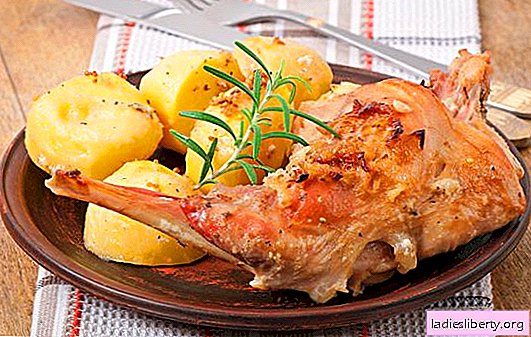
It is hard to imagine that a plant like garlic can be affected by disease.
People eat it to prevent many diseases, but garlic itself can also hurt.
Garlic diseases are quite common.
They are caused by viruses or breach of growing conditions.
Garlic Viral Diseases
1. False powdery mildew - a dangerous virus that infects garlic
The virus is caused by fungi that are found not only in the soil, but also in the heads. It progresses only under favorable conditions:
- thickening of landings;
- sharp jumps in temperature;
- humidity is too high.
How to recognize a diseased plant? The leaves of garlic are first covered with yellow or brown spots, on the site of which a gray coating appears. With the advanced form of the disease, the entire leaf surface is infected, and the virus enters the head itself. With the penetration of the fungus into the bulb, it ceases to grow and develop, later dies completely.
How to deal with powdery mildew? One of the important factors is the prevention and treatment of seed. When preparing teeth, you should pay attention to their scales. If it is too dense, then this indicates a possible infection. Such teeth are unsuitable for planting.
Powdery mildew found on growing garlic? At the first sign of damage, all damaged areas of the leaves should be removed. The following is the treatment of plantings with copper sulfate. After harvesting, all heads must be thoroughly dried.
2. Leaf rust: garlic leaves turn yellow in spring
Many summer residents complain of yellowing leaves in winter garlic. Despite good care, watering and fertilizing leaves still die. It's all about the virus that infects garlic. Rust is spread by fungi that spread over the entire surface of the plant.
How to detect rust on the leaves? In diseased plants, convex yellow spots appear on the leaves, which darken over time and lead to drying out of the leaves.
Methods for combating rust fungus begin even before planting cloves. All seed material must be treated and disinfected. In adult plants, the affected leaves are chopped off and sprayed with garlic with a Bordeaux mixture.

3. Fusarium - yellowing of individual leaves of garlic in the spring. What to do and how to recognize the disease?
It is possible to identify a fungal disease of garlic by individual yellowed leaves or brown stripes on them. If the disease is started, then the defeat will go to the whole plant and the bulb, which rots. It is impossible to store the affected heads, they are covered with a white coating.
To combat the fusarium rot of garlic, Bordeaux liquid and copper sulfate are used. Spraying of plantings is carried out with an interval of several weeks.
4. Cervical rot of garlic: storage diseases
Recognizing this disease during the growing season is quite difficult. As a rule, during storage of an already harvested crop, it is manifested by the softness of the neck and the appearance of gray spots on the bulb. Affected garlic heads have a specific rot odor.
The disease develops on overfed soils. When using large doses of nitrogen-containing fertilizers, garlic is affected by cervical rot. All plant nutrition should be stopped a month before harvest. Garlic is harvested only in dry weather. Before laying for storage, the heads dry well. It is better to store the crop at a temperature of 0 degrees. This will stop the development of neck rot.
5. Black mold: dry the heads of garlic
This fungal disease develops in the heads during storage of garlic. As a rule, the storage conditions are too favorable for the development of mold. A damaged bulb dries completely. If you break the head, then under its skin you can find black dust. This is the spore of the fungus, which is transferred to other bulbs.
You can get rid of the disease with the help of the Fitosporin preparation, which processes planting stock, storage and planting of garlic. After harvesting, the crop is well dried, the necessary storage conditions are observed, and dried bulbs are removed on time.
6. Green rot: storage problems
The development of green rot occurs when the humidity is too high during storage. In places of cuts or dents, a pathogenic fungus forms, which affects the entire bulb. Rot can be recognized by greenish spots.
Timely disinfection of the storage and its ventilation, good drying of the crop will help get rid of green rot.
7. White rot: fungal root disease
The leaves of winter garlic turn yellow and die, and a white mycelium forms on the roots with a bloom. In this case, black dots appear on the head of garlic, which lead to decay. You can save the plant only at the initial stage of the disease. All diseased leaves are removed, they are sprayed with antifungal drugs.
Fungal diseases of garlic spread quite quickly and can ruin the entire crop. At the slightest sign of defeat, immediately apply the available methods of struggle. As a prevention of all fungal diseases, rot and yellowing of leaves in garlic, the soil is mulched from early spring. For these purposes, last year’s compost is used.
Pests on garlic: why does the leaves of winter garlic turn yellow?
Not only the defeat of fungal diseases leads to yellowing of leaves in winter garlic. Often the cause of wilting plants become pests that settle on various parts of garlic.
1. Stem nematode on garlic leaves
This little worm gives a lot of trouble to the gardener. The pest is populated on the stalks and roots of garlic, eating its juice. The damaged plant first signals yellowing of the leaves in spring, drying out of the roots. After the complete death of garlic, the worm moves to another plant and continues to develop, lay eggs.
If a nematode has settled on the site, then all damaged plants need to be burned, and the soil should be treated with Thunderbolt. You can return garlic to its original place in two years.
A good prevention from a gluttonous nematode will be saline. Prepare it from 1 tbsp. l salt, which is bred in 3 liters. water. In such a solution, you need to soak the cloves of garlic before planting. Sometimes salt water needs to spill the soil in the beds.
2. Root tick
The pest prevents garlic from forming full heads. He climbs inside the bulb through the bottom and inhibits its growth. Damaged bulbs are discarded.
As a prophylaxis against ticks on garlic, crop rotation will help. Planting garlic in the same place is not recommended. In the beds where onions, potatoes, cabbage or legumes were grown, garlic should not be planted.
3. Onion fly
In June, the onion fly, which is populated on leaves or flower shoots at the base of the stem and harms the plant’s sap, harms the plantings of garlic, lays eggs. Larvae of a fly eat out heads of garlic. To control the pest, a metophos suspension is used.
Useful tips to the gardener: get rid of yellowed leaves and rot on garlic
Growing garlic requires a special approach. Timely inspection of the beds and proper planting care will help get rid of many problems when growing garlic.
All garlic diseases arise from irregular watering. Excessive humidity contributes to the development of fungal diseases.
Too high air temperature during storage increases the risk of infection.
Garlic should be fed carefully, do not abuse nitrogen fertilizers. The use of mineral complexes significantly reduces the appearance of pests on garlic.
It is necessary to lay in storage well-dried heads.
Periodically check the crop and timely discard damaged heads during storage.
Before planting, carry out a thorough digging of the soil, processing of planting material.
When growing, adhere to crop rotation and arrange beds after favorable crops.
Plant and harvest garlic from a certain time frame.
A caring summer resident should pay attention to the slightest change in the appearance of the plant. This will help identify signs of disease or pests on the garlic. Processing and spraying in the early stages bring results, allow you to save the crop.











